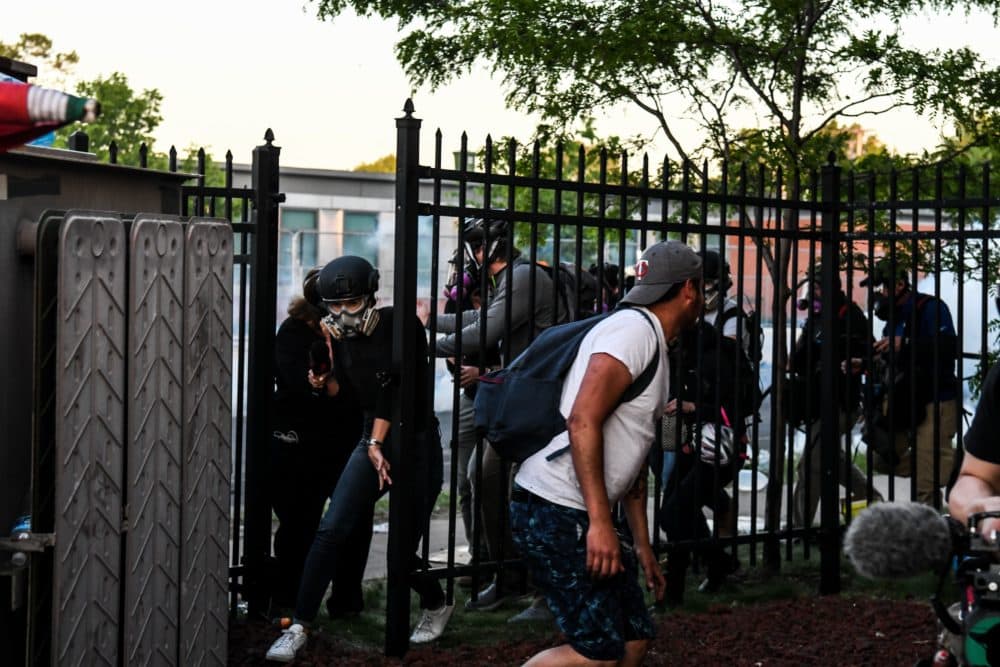Advertisement
On Point's Coronavirus Hours
The Media's Coverage Of The George Floyd Protests Against Police Brutality

We discuss the nationwide protests over the killing of George Floyd, and how the media is covering, framing, and often becoming part of the story.
Guests
Michele Norris, opinions contributor and consultant for the Washington Post. Founding director of the Race Card Project. Author of "The Grace of Silence: A Memoir." (@michele_norris)
David Folkenflik, On Point co-host. NPR media correspondent. (@davidfolkenflik)
From The Reading List
Washington Post: "How Western media would cover Minneapolis if it happened in another country" — "In recent years, the international community has sounded the alarm on the deteriorating political and human rights situation in the United States under the regime of Donald Trump."
NPR: "'Unarmed Black Man' Doesn't Mean What You Think It Means" — "When journalists write or broadcast these words — 'unarmed black man'— what do you hear? It's a phrase that has become pervasive in the American news media, including on NPR's airwaves and in its digital news stories."
The Guardian: "Rage and anguish: how the US papers have covered the George Floyd protests" — "The front pages of US newspapers over the past few days tell of the double tragedy of a nation rocked by protests over the death of George Floyd and the growing coronavirus toll."
Washington Post: "Opinion: How Amy Cooper and George Floyd represent two versions of racism that black Americans face every day" — "How refreshing it would have been if Amy Cooper had said, 'Yep, that was a pretty clear act of racism on my part,' instead of apologizing to 'that man' and insisting that she was not really a racist."
Vox: "Police targeted journalists covering the George Floyd protests" — "On Friday night, photojournalist Linda Tirado was shot in the eye by a rubber bullet while covering an anti-police brutality protest in Minneapolis — one of more than two dozen incidents of journalists experiencing violence while covering the recent demonstrations."
Washington Post: "‘The norms have broken down’: Shock as journalists are arrested, injured by police while trying to cover the story" — "Ali Velshi knew almost instantly what had happened when he felt a sharp pain in his leg Saturday night in Minneapolis: He’d been hit with a rubber bullet fired by police."
New York Times: "A Reporter’s Cry on Live TV: ‘I’m Getting Shot! I’m Getting Shot!’" — "Linda Tirado, a freelance photographer, activist and author, was shot in the left eye Friday while covering the street protests in Minneapolis."
Washington Post: "‘Never seen anything like this’: A CNN journalist’s arrest on live television shocks nation and inflames racial wounds" — "CNN reporter Omar Jimenez began his workday before dawn on Friday, prepared to cover the aftermath of protests in Minneapolis that had turned destructive. Smoke still wafted and a small fire flickered from the remains of a liquor store burned out the night before as he and his crew set up their live shot on a broad avenue."
Buzzfeed News: "We’re Keeping A Running List Of Hoaxes And Misleading Posts About The Nationwide Police Brutality Protests" — "The death of George Floyd, an unarmed black man who died after a Minneapolis police officer who used a knee chokehold on him, has sparked protests all over the country. As they gained traction, so did online hoaxes and disinformation about them. BuzzFeed News is keeping a running list of the false and misleading information."
Los Angeles Times: "George Floyd and the special hell reserved for black journalists covering his killing" — "When my cell rang, an unfamiliar number popped up on the screen. Normally I ignore these calls, certain my service provider has sold my information to half the country’s telemarketing companies. This time I picked up."
Vox: "What we’re missing when we condemn “violence” at protests" — "A pandemic has taken the lives of more than 100,000 Americans and put more than 30 million out of work, and to top it off, there has been an almost 30-day, caught-on-tape spree of police and vigilante violence against black people. For some, it may feel like the nation is on the brink of near-biblical levels of chaos."
Washington Post: "Opinion: The ‘us and them’ pandemic shows America is still impervious to black pain" — "When the official counts began to show that covid-19 was hitting black communities in America with a particularly deadly punch, I had to admit to feeling dread on two levels."
The Conversation: "Riot or resistance? How media frames unrest in Minneapolis will shape public’s view of protest" — "A teenager held her phone steady enough to capture the final moments of George Perry Floyd’s life as he apparently suffocated under the weight of a Minneapolis police officer’s knee on his neck. The video went viral."
This program aired on June 1, 2020.

